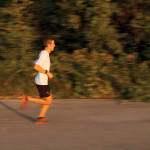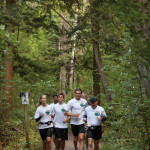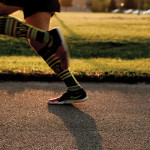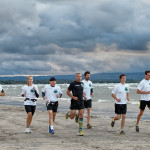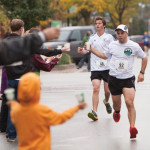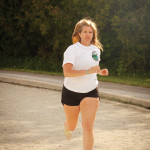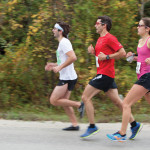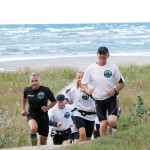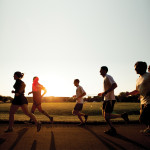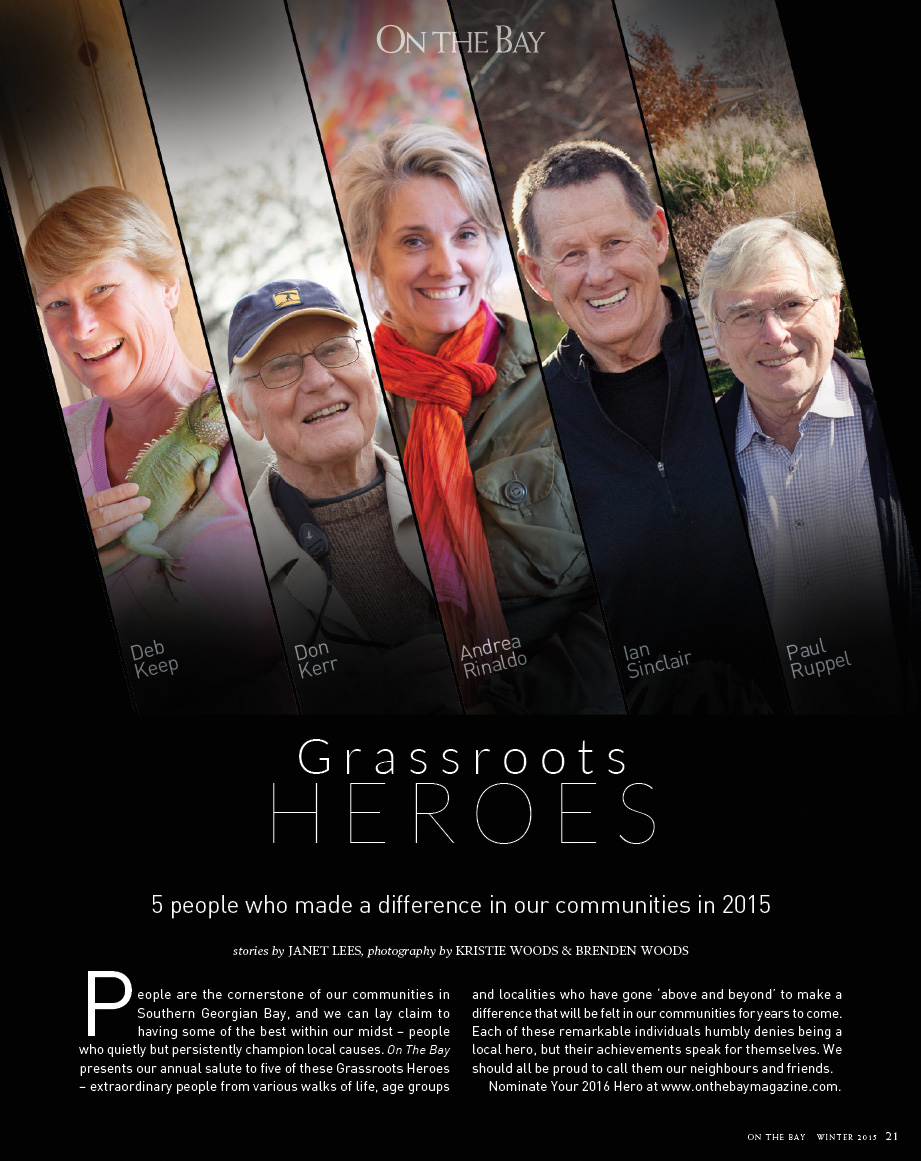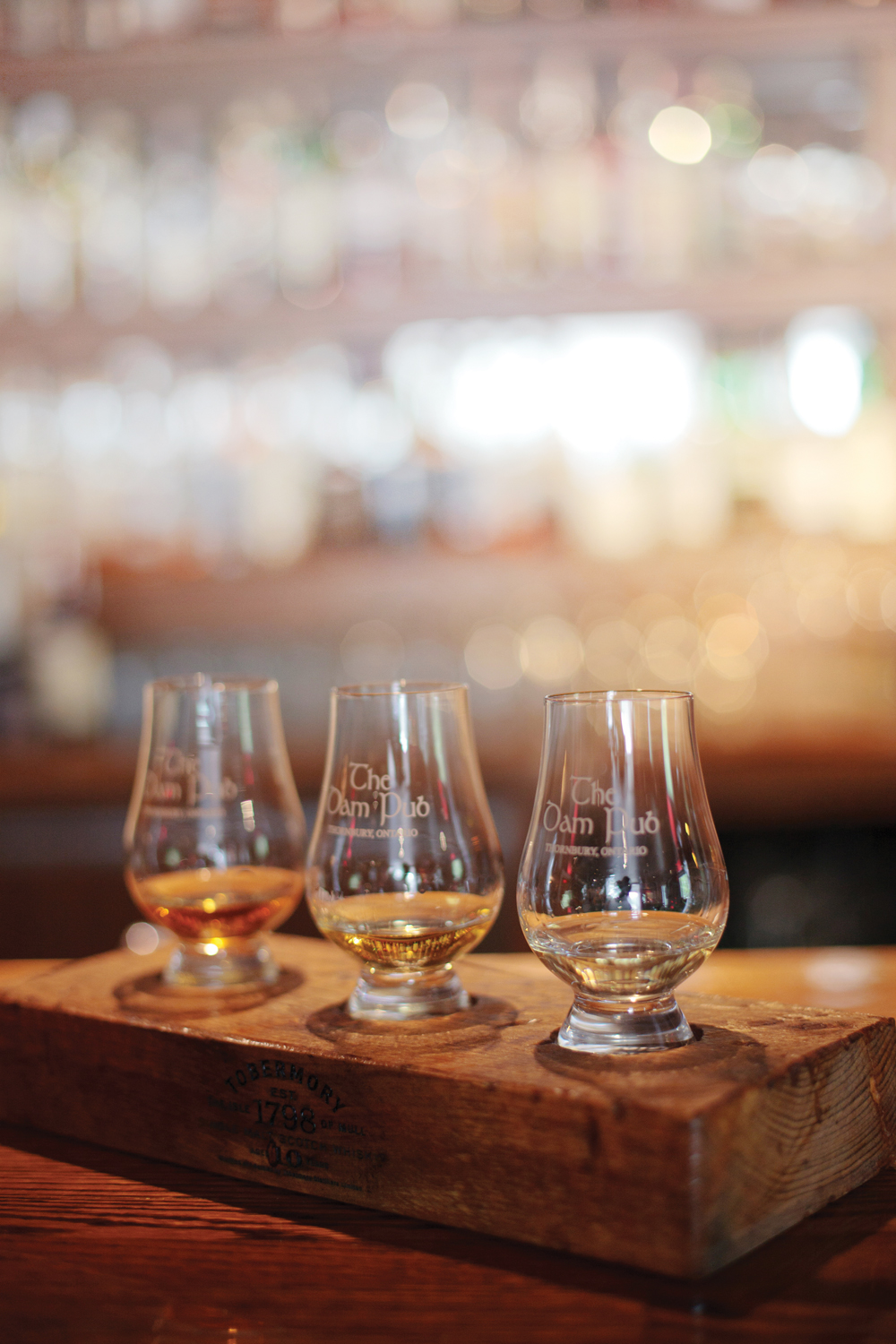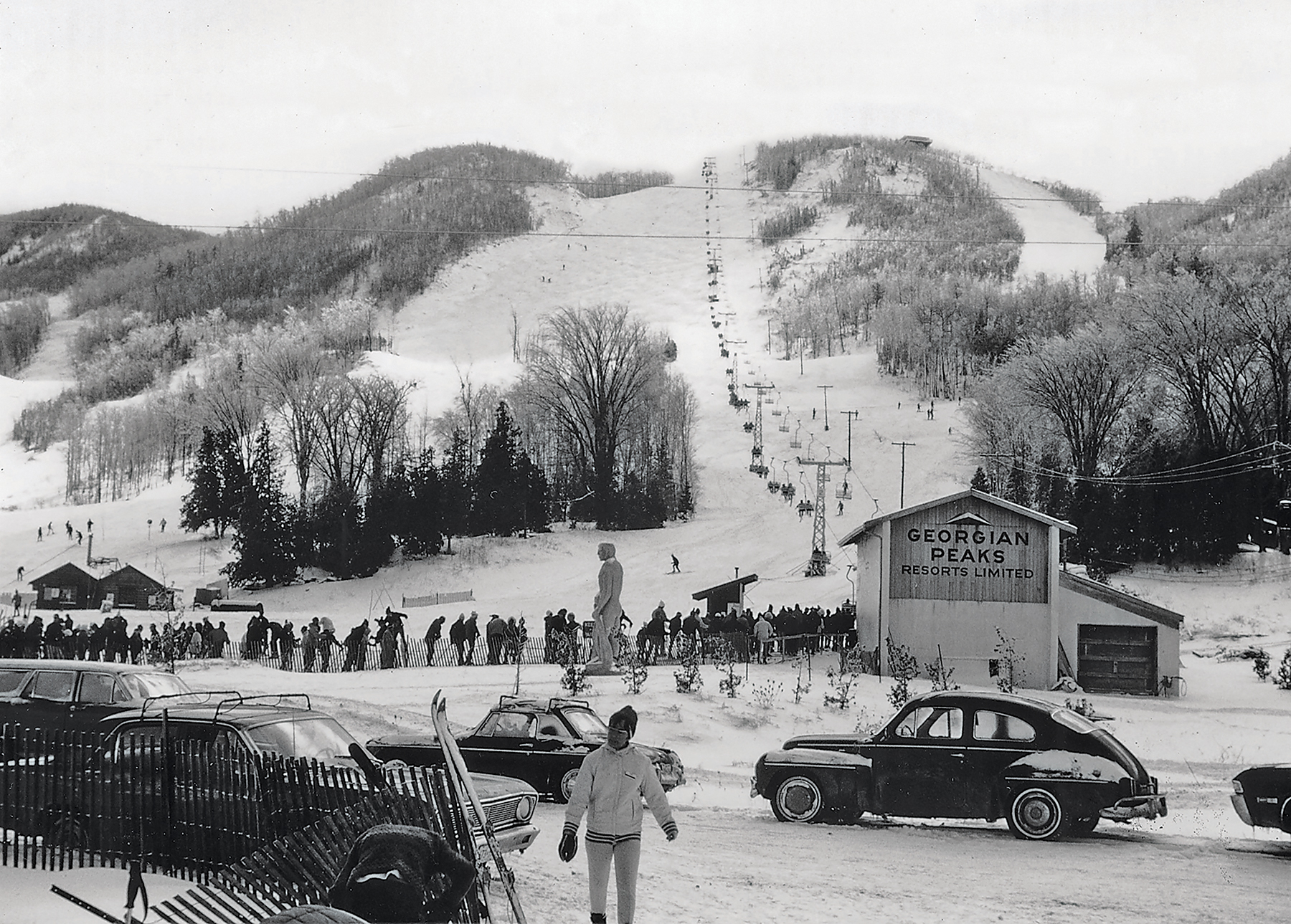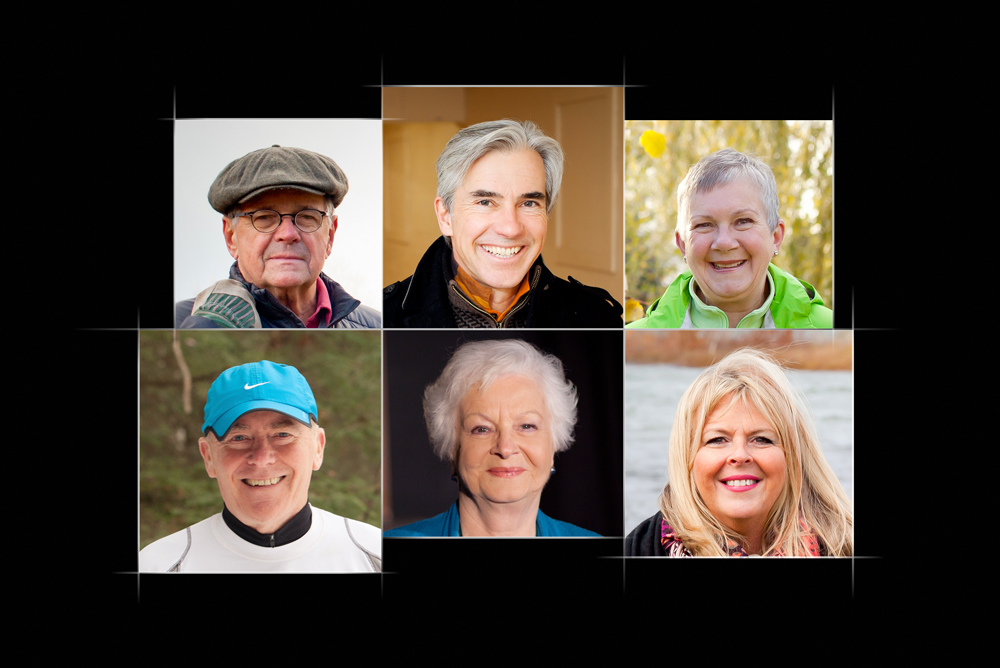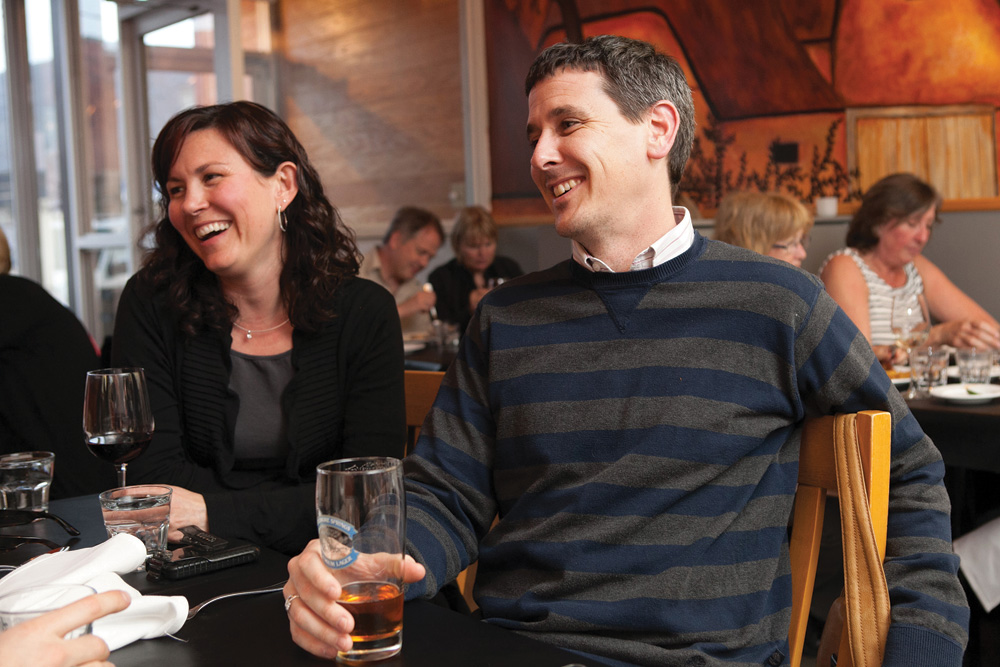Running is more popular than ever, and Southern Georgian Bay is on solid footing with passionate advocates and high-profile running events
story by Marc Huminilowycz, photography by Christa & Richard Galloway

One day when she was in her 30s, local resident Andrea Russell laced up a neglected pair of athletic shoes and began running to relieve the pressure of working long hours. A self-professed former “gym rat,” Russell was finding it increasingly difficult to make time for the gym. Being self-employed, she quickly realized that she could easily take 20 minutes any time to head out her front door for a jog.
“The first time out, I wasn’t sure if I was walking or running,” recalls Russell, “but I quickly realized that the activity was enhancing my mental clarity and focus, while melting away the stresses of the day. ‘That was easy,’ I thought. At a time in my life when I needed to simplify, running couldn’t be simpler.” Russell used to maintain a regular running routine, but this time the activity felt different. “Before, it was a painful regimen – something I had to do. Now, I was running for different reasons, doing it for myself instead of to myself. It felt liberating!”
Russell is not alone in her enthusiasm for the sport of running, which has experienced a major resurgence in popularity in North America and around the world over the past few years. This year’s Boston Marathon attracted a record 36,000 runners – 9,000 more than 2013, despite the tragic bombings that marred the venerable event last year. From Chicago to Berlin to Toronto to New York, large urban marathons are selling out almost immediately. After a rush to sign up online led to server crashes, many big races have switched to a lottery system for registration due to unprecedented number of runners wishing to participate. In Southern Georgian Bay, events from marathons and half marathons to triathlons and even ultramarathons are attracting record numbers of runners every year, and the list of local races continues to grow.
Why is running so popular? “It’s cheap and accessible – all you need is a good pair of shoes and the open road. And it is the most basic of functions – an expression of our natural abilities, relying only on your own power, muscles and steam,” Russell explains. She also attributes much of today’s running craze to best-selling books, like Born to Run by Christopher McDougall, and the spin-off media attention they have generated. “In the ’80s, people flocked to gyms. ‘No pain, no gain’ was the fitness mantra. But in the last decade, this transitioned to a more holistic, body-mind-spirit approach to fitness. Now people are looking for activities that nurture all those things, and running delivers all those.”
Russell is co-founder of The Georgian Triangle Running Club (GTRC), a local organization with about 50 active members, and growing. Locally, she credits popularity of running to what she calls a collective group of people with common interests. “There has been a groundswell of good health in our area over the past few years,” Russell observes. “A lot of people are moving to Southern Georgian Bay for the active lifestyle, the abundance of activities and the amazing natural beauty the region has to offer.”
The Georgian Triangle Running Club focuses on various running disciplines, both competitive and non-competitive: road and distance, trail and hill, triathlon, beginner and youth. Membership is “amazingly diverse,” with novices as young as 12 and runners in their 80s. One club member participated in this year’s Boston Marathon.
Membership in the club offers many benefits to local runners, says Russell. Instead of running alone, they enjoy the social aspect and motivation of working out with like-minded individuals, participating in a forum on Facebook, and special discounts on shoes, GPS equipment and other gear. While only a few ‘die-hard’ members run in the winter, most enhance their running throughout the year with a myriad of activities available in our region, such as skiing (Nordic and alpine), snowshoeing, cycling and kayaking. “We’re an active bunch,” she notes.
This year, on October 14, the Georgian Triangle Running Club will once again be the host club for Run Collingwood, a half marathon and 10K run which made its debut in 2013. Race director Nick Brindisi, also vice president and running coach with the GTRC, organized the event to help raise funds for the Collingwood General and Marine Hospital. “I ran 75K in 2011 and 100K in 2012, both non-stop, personally raising $5,500 for the hospital,” says Brindisi. “While I did find satisfaction in doing it on my own, I decided to get others involved and create an annual running event.”
Brindisi’s personal running career began in Southern Georgian Bay, where he became competitive at Collingwood Collegiate Institute. A self-described “lifetime runner,” Brindisi has traversed the Niagara Escarpment and local ski hills (before the activity became trendy), and raced in every distance discipline over the years: 5K, 10K, half marathons, marathons and ultramarathons. His most significant achievement in the latter category was completing 100 km of the Sinister 7 Ultra, a gruelling 160-Kilometre race over Alberta’s Crowsnest Pass covering 19,000 feet vertical – in 17 hours. (Brindisi plans to go back this summer and “finish the job.”)
What makes an avid runner like Nick Brindisi tick? “At my current competitive level, running centres me. It makes me who I am. It’s the ultimate stress-buster for me, and it gives me a totally different way of looking at the world,” he says. After completing an ultramarathon, Brindisi claims to experience a “hyper reality”: his senses become heightened and he feels completely relaxed. “Food tastes amazing.”
After promoting the Toronto Marathon and establishing numerous connections over the past years through his marketing company, Brindisi organized the first Run Collingwood event last fall, complete with certification from Athletics Canada for both the half marathon and 10K courses.
The half marathon is a scenic 21.1-kilometre race that begins and ends at Fisher Field in Collingwood. The course moves through downtown via Hurontario and Ontario Streets, then heads for the countryside via Raglan St., Ron Emo Rd., Sanford Fleming Blvd. and 6th Line. Turning west on Poplar Sideroad, runners are treated to spectacular views of the Escarpment. At 16 km, the course turns north following the base of the Osler ski hills. After a long downhill, the race turns east again to the finish at Fisher Field, where tents are set up to offer weary runners physiotherapy and massage. The 10K race offers an equally fast and scenic rural run conducive to running personal bests.
The 2013 Run Collingwood event was a runaway success in its inaugural year, attracting approximately 260 runners ranging in age from 16 to 69, plus about 100 participants in a children’s race. “This year, we’re expecting over 1,000 runners,” says Brindisi. “Word of mouth has created a buzz in Toronto and beyond. We’ve got a reputation as a fast course, with a time of 1:18 in our half marathon posted by the winner, from Owen Sound. We even had a couple of Kenyan runners, one of whom I coach.” All race entrants will receive a Karbon technical running shirt and a participation medal.
The Thornbury-Clarksburg Rotary Club will also be holding its second annual running event, on October 19. Billed as “a run through Apple Country,” Run Blue Mountains was founded by local running enthusiast Jeremy Wentworth-Stanley, who is also the race’s signature sponsor. The event, geared to both serious runners and families alike, will feature a full line-up of races this year: a half marathon, a 10K run/walk a 5K run, 5K walk and a popular 1K Kids’ Fun Run. Run Blue Mountains will centre around Thornbury’s Beaver Valley Community Centre, where all races will begin and finish and runners can refresh themselves at the Runners’ Café, enjoy music and browse local retailer displays.
Participants will wind their way though Thornbury and Clarksburg, then out to apple country in the beautiful Beaver Valley, and back to the finish line. “The 2013 event was a great success, with about 300 participants – not bad for our first year,” says race director Linda Wykes. “Runners love to run, and many bike as well. They like the adrenaline rush.”
The inaugural event received excellent reviews – 5 Bananas (out of 5) from most participants on mynextrace.com, an online forum where runners post comments and grade the races in which they participate. As in 2013, a large portion of Run Blue Mountains’ proceeds will go to support healthy lifestyle activities for children and youth, such as after-school programs at Beaver Valley Community School and the Meaford Junior Coyotes Running Club.
South of Collingwood in the Village of Creemore, two other races have been gaining in popularity over the years: one a family race event centred around a popular community festival; the other a much more extreme contest for only the fittest athletes.
In 2012, a couple of local running enthusiasts decided that it would be a good idea to hold a casual 5K race during the annual Creemore Copper Kettle Festival, which features an antique car show, live music and, of course, a beer tent serving Creemore Springs beer.
This year’s Copper Kettle Dash, presented by Tim Hortons Stayner, will take place on August 23, offering a 5K walk/run and a 10K run beginning and ending at the Creemore Community Arena. Age category prizes will be given away, and each participant will receive a ceramic medal hand-crafted by race director Lee Ann Cohen, a potter and competitive ultramarathon runner. From 75 registrants in 2013, race organizers Cohen and her partner Pierre Marcoux hope to grow the event considerably to 600 people in the coming years.
On July 5, the eighth annual Creemore Vertical Challenge, an ultramarathon event not for the faint of heart, will test the endurance of athletes from across the continent and beyond, there will be a runner from Dubai this year. A 25K race and a gruelling 50K competition will both start at Nottawasaga Concession 3 and 6/7 Sideroad just south of Creemore. The course, an hourglass loop with 50 per cent trail and 50 per cent country road, is hilly, climbing the Escarpment twice with about 875 metres of vertical ascent per loop.
Started in 2007 by race director Pierre Marcoux and his partner Lee Anne Cohen, the Creemore Vertical Challenge is part of both the Ontario Trail and Ontario Ultra Series, which includes the largest race of its kind in Ontario – Run for the Toad (Paris), now in its 13th year. The organizers have applied for Bronze Label Race status, which would make Creemore a signature race destination on the IAU (International Association of Ultrarunners) circuit.
Another international ultramarathon event that is causing big buzz locally is the North Face Endurance Challenge Series, which debuts at Blue Mountain Resort July 12 and 13. This marks the first international expansion for the series within North America, and the Blue Mountain course promises “the most pronounced elevation gain trail race in all of Ontario” as it “cruises along the Niagara Escarpment on the western shores of Georgian Bay and navigates through the ski trails of the Blue Mountains.” The two-day event will feature a gruelling 50 mile as well as a 50K, along with a marathon, marathon relay, half marathon, 10K, 5K and kid’s run. Adding such a prestigious series to our already impressive roster of running events will put our region firmly on the running map.
According to Pierre Marcoux, marathons and ultramarathons are not just for elite athletes, as they used to be. “Better equipment, better training, better nutrition and a shift in perception have changed the sports and made them accessible to anyone. Now they’re mainstream,” he explains. “These races used to involve one year of painful training. Now contestants run every other day before the start of the race. They’re not just for the select runners anymore.”
As an example of how marathon racing has changed over the years, Marcoux points out two startling facts from the 1960s: women were not allowed to run the long distance race because it was believed that they would “damage” themselves; water stations were non-existent. “Everybody thought that it wasn’t healthy to drink while running,” he says.
Today, it is an accepted rule that distance runners need to replenish their fluids during a race. You can lose around half a litre of water for each hour that you exercise, and substantially more on a hot day. And, of course, women are excelling at the sport.
Marcoux took up running in 1975 after he tore a cartilage in his knee during a basketball game, requiring surgery. As part of his rehabilitation, he was encouraged by his doctor to keep the muscles around his knee long in order to align the knee. Running was an obvious choice, and he has been doing it ever since. When asked what he likes most about running, Marcoux replies jokingly, “I can eat whatever I want” – then goes on to extol its more meaningful virtues. “It strengthens my heart, my back and my core muscles, and I can do almost any other sport.”
As a competitive ultramarathon athlete, Marcoux has some sage advice for anyone considering embarking on a running regimen. “Start with good shoes, preferably from a retailer specializing in running,” he says. “For the first two weeks, don’t run more than once every two days. Run/walk at first – run until you’re tired, then walk, then recover, then run again. Don’t worry about distance. Run by time. Start with 15 minutes, then increase your time gradually.” Marcoux emphasizes the importance of taking it slowly. He points out that, while cardiovascular fitness and leg muscle strength improve dramatically in as little as two weeks, ligaments and tendons can take six weeks to fully strengthen.
If running for fun, fitness and competition leaves you wanting more, there are also opportunities to run for charity. The Canadian Breast Cancer Foundation CIBC Run for the Cure is Canada’s largest single-day, volunteer-led fundraising event dedicated to raising funds for breast cancer research, education and awareness programs. This year the 5K and 1K runners and walkers will depart from Blue Mountain Village (in the past the start/end point was Collingwood).
Another charity run ties Southern Georgian Bay to the Greater Toronto Area. The Sears Great Canadian Run Toronto, now in its fourth successful year, challenges teams and solo runners to take part in a 100-kilometre road/trail mix relay race that begins in Caledon, winds its way through the scenic Niagara Escarpment and finishes at Blue Mountain Village, where runners can celebrate their achievements at a post-run party. The annual event takes place on September 20. Money raised will go towards paediatric oncology initiatives to “end kids’ cancer.”
Researching this article and interviewing the many happy runners who daily traverse the roads and trails of Southern Georgian Bay, this writer, who has always considered himself active and reasonably fit, was moved by their absolute dedication to and enthusiasm for the sport. Maybe they are onto something. Skis, skates and snowshoes helped many of us get through a very long and intense winter this year. Now that the warm weather has finally arrived, perhaps running is an activity that deserves serious consideration.
As we continue to enjoy the abundance of activities our region has to offer, we should all consider the pure simplicity and joy of running as a vital part of our four-season repertoire. After all, what could be easier? Just lace up a pair of shoes, and go. ❧






